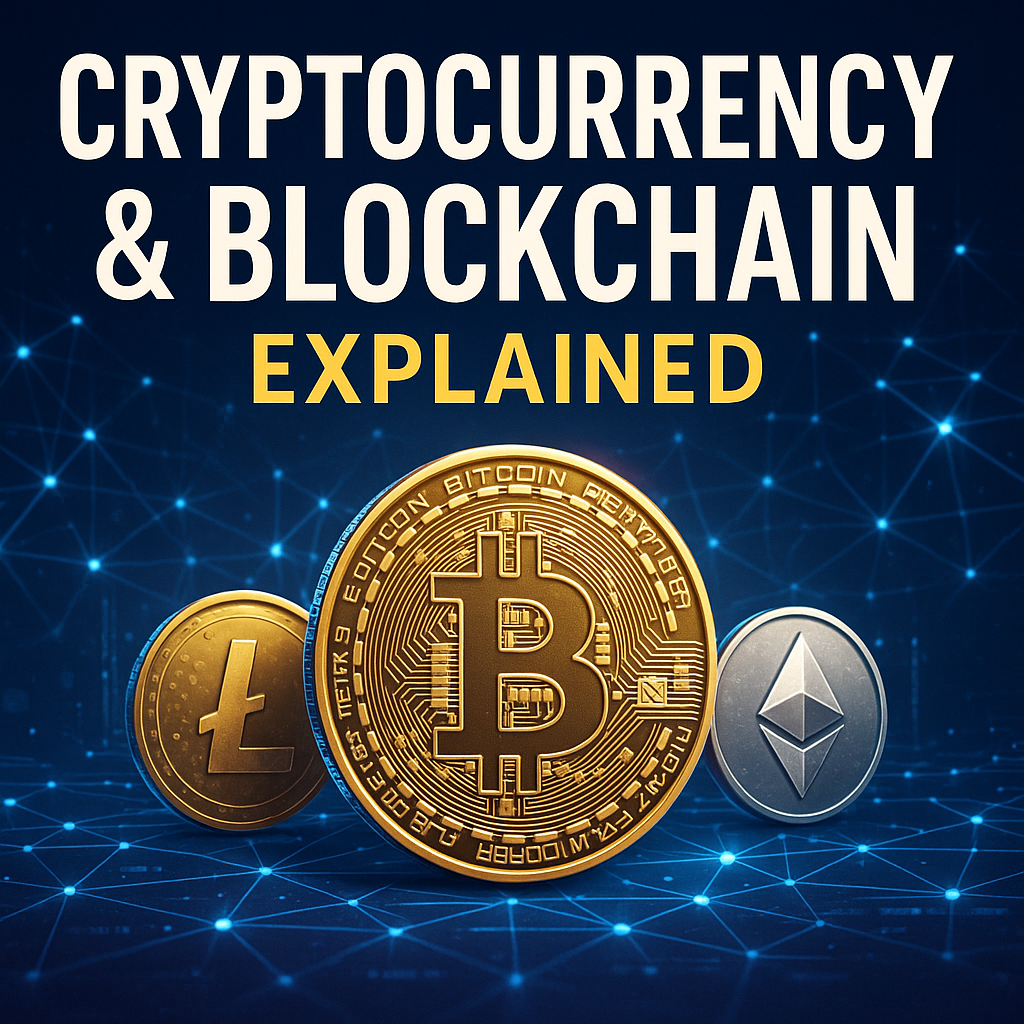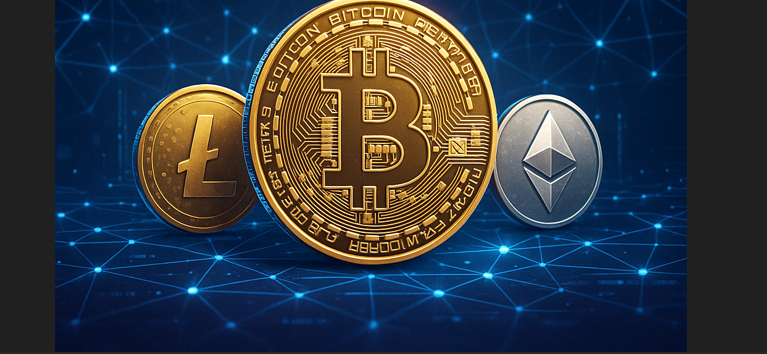“The new-age money, and the honest system behind it”

🧠 Why this article?
Everyone’s talking about it:
- “I’ve invested in crypto.”
- “Bitcoin just crashed.”
- “Blockchain is secure.”
But do we actually know:
What is cryptocurrency? What is blockchain? Are they the same thing?
How is money created here? Who even invented this concept?
Let’s understand everything in one go — from scratch, and in a way that even a non-tech person would get.
🌐 Blockchain vs Cryptocurrency – What’s the difference?
Imagine Blockchain as a digital ledger —
And Cryptocurrency as the money recorded in that ledger.
| Blockchain | Cryptocurrency |
|---|---|
| A technology/platform | A digital currency built on it |
| Like a ledger | Like the value recorded in it |
| Transparent and tamper-proof | Medium of digital exchange |
| Example: Bitcoin Blockchain | Example: Bitcoin, Ethereum |
Without blockchain, cryptocurrency wouldn’t exist.
But blockchain has uses far beyond crypto — such as in voting, land records, and supply chains.
🔧 What Exactly is Blockchain?
Imagine a register where everyone is allowed to write —
But no one can erase anything, and everyone gets a copy of every change.
That’s essentially blockchain.
- Block – A chunk of data (like a transaction)
- Chain – Each block is linked to the previous one using cryptographic methods
- Decentralized – No central server or single authority
- Immutable – Once written, data cannot be changed
Think of a farmer writing each harvest in a notebook and never tearing pages out. That’s how transactions are recorded in blockchain — permanent and secure.
💰 What is Cryptocurrency?
Cryptocurrency is a digital currency that works on a blockchain platform.
No paper, no coins — just a digital token whose value is accepted by consensus.
What can you do with it?
- Send money without needing a bank
- Buy goods or services online
- Invest, like stocks
- Create smart contracts that run automatically
🛠️ How Is Money Created? – The Mining Process
Here’s where it gets interesting.
Cryptocurrency isn’t printed — it’s mined, like gold or coal.
Here’s how:
- Every transaction is verified by the network
- This verification requires solving complex mathematical puzzles
- The first to solve it gets a reward in new coins — that’s the miner
For example, Bitcoin miners solve a puzzle and get rewarded in Bitcoins — that’s how new Bitcoins are introduced.
Mining involves:
- High computational power
- Massive electricity usage
- Competitive computing
🧑🔬 Who Invented All This?
In 2008, an unknown entity named Satoshi Nakamoto introduced the concept.
No one knows whether Satoshi is a person, a group, or something else.
But they gave the world:
✅ Bitcoin
✅ The concept of blockchain
✅ Peer-to-peer transactions without middlemen
Satoshi’s core idea was:
“Why trust banks that caused financial crashes? Let’s trust math and open code.”
📊 Analogy: UPI vs Bitcoin
Let’s compare this new digital money with something familiar — UPI.
| Feature | UPI / Bank Transfer | Bitcoin / Cryptocurrency |
|---|---|---|
| Controlled By | RBI / Banks | No central authority |
| Fees | Low | Varies (often higher) |
| Speed | Real-time (in India) | Minutes to hours |
| Control | Bank controls your money | You control via private key |
| Reversible? | Sometimes | No – irreversible once sent |
🏦 Is Cryptocurrency Legal in India?
- Owning crypto is legal
- But it’s not recognized as official currency
- RBI is testing its own digital currency (CBDC)
- Government has imposed 30% tax + 1% TDS on crypto profits
⚠️ Risks You Should Know
- Crypto prices are highly volatile
- If your wallet is hacked — funds are gone
- No regulation means no legal protection
- Scams and fake coins are everywhere
🔮 The Future of Blockchain & Crypto
✅ Blockchain is being used in elections, land records, healthcare, and education
✅ Cryptocurrency has become an investment alternative
✅ Metaverse, NFTs, and Web3 — all are powered by blockchain foundations
📍 Real-World Use Case: Land Records on Blockchain – Andhra Pradesh, India
⚠️ The Problem:
Land ownership disputes are among the most common and critical legal issues in India.
Common challenges include:
- Duplicate land documents
- Tampering with official records
- Manual entry errors
- Bribery and corruption in land offices
In many cases, two people claim ownership of the same land — because documents can be manipulated, and there’s no way to verify the real owner.
🛠️ The Blockchain Solution:
The Government of Andhra Pradesh launched a pilot project to migrate land records to a blockchain-based system.
Here’s how they tackled the issue:
- Every land parcel was assigned a unique digital ID
- Each transaction (sale, inheritance, gift) was recorded as a new block
- Records became tamper-proof — no unauthorized changes possible
- Citizens were given transparent access through a public digital ledger
💥 The Outcome:
- No more duplicate ownership claims
- Corruption in land offices dropped significantly
- Public trust in land record authenticity increased
- Entire verification process became online and paperless
🧠 The Takeaway:
Blockchain isn’t just for techies or crypto investors.
It’s solving real-world challenges where data integrity, transparency, and public trust are essential.
📌 Final Takeaway:
Blockchain is the engine. Cryptocurrency is the car.
Both are futuristic — but they demand understanding and caution.
Don’t just dive into trends.
Learn. Understand. Think. And then participate.
✍️ Your Thoughts?
Have you ever invested in crypto?
Does the idea of blockchain make more sense now?
Seen any real-life applications of it around you?
👇 Drop your thoughts in the comments —
Let’s build knowledge together and make tech more accessible, one concept at a time.

